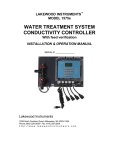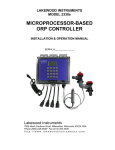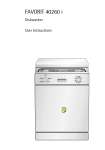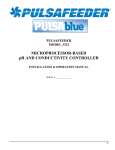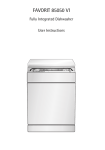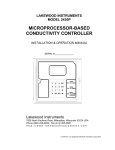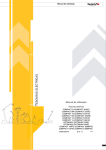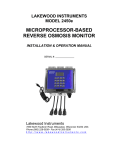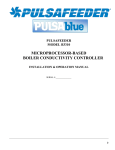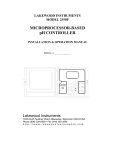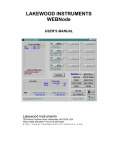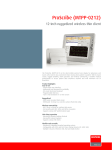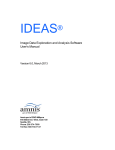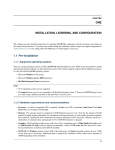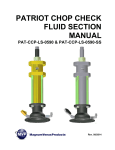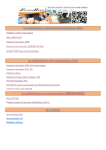Download 1520/30e MANUAL - Lakewood Instruments
Transcript
LAKEWOOD INSTRUMENTS™
MODEL 1520/1530e
WATER TREATMENT SYSTEM
PH or ORP CONTROLLER
INSTALLATION & OPERATION MANUAL
SERIAL #: _______________
Lakewood Instruments
7838 North Faulkner Road, Milwaukee, WI 53224 USA
Phone (800) 228-0839 • Fax (414) 355-3508
http://www.lakewoodinstruments.com
Lakewood Instruments™ Model 1520/30e Controller
Quick Installation Sheet
1.
Install the controller on a flat, non-vibrating surface. Use the four (4) supplied mounting feet.
Do not mount the controller to a steel object that has a large temperature change (side of
cooling tower, etc). This can cause water to condense inside the enclosure.
2. Open the front cover keypad of the Model 1520/30e Controller by turning the two holding
screws counter-clockwise.
3. Install water meters, chemical pumps, plumbing assemblies and the pH or ORP sensor. Configure
Jumpers H1 and H2 for your sensor. (See drawings in back for instructions.)
4. Wire the flow switch (use jumper wire for no flow switch), pH or ORP sensor, water meters and
4-20 mA output/input, if applicable (see drawing on back). Ensure wiring connections are correct
or damage may occur.
5. If doing a conduit installation, remove receptacles and wire pumps and bleed valve directly to the
terminals. If using a motorized ball valve, wire as per wiring instructions. Refer to the
instruction manual for more details.
6. Set the power selector switch to the appropriate voltage (115 or 230 VAC). For 230 VAC
applications the power cord and receptacles must be removed.
7. Close the front cover keypad making sure both holding screws are tightened.
8. Plug in chemical pumps and bleed valve to controller (unless hardwired as per step #5).
9. Apply power to the 1520/30e controller, press “CLR” twice, press “7” System setup, press “2”
Initialization, press “2” Whole controller, press “1” Yes. After initialization, press the “CLR” key
several times until you get to the main menu.
10. Press “1” Process, Press “ENT”. This screen allows manual control of the relay outputs to test
the chemical pumps and bleed valve. Press “CLR” to return to the Process screen.
11. Press “CLR” to get to the main menu. Press “7” System Setup, press “1” Process Parameters,
press “1” to set up the Damping. Press “2” Temp Compensation, select the temperature
compensator for your sensor. Press “3” to set up the amount of temperature compensation.
Press “CLR” several times to return to the main menu, press “1” for the Process screen.
12. To calibrate pH or ORP take a sample with a handheld pH or ORP meter, press the “PRO” button,
press “1” for a single point calibration or press “2” for a two-point calibration, type in pH or
ORP value, press “ENT”.
13. Program the 1520/30e relays for bleed and chemical feed schemes. See instruction manual for
more details.
IMPORTANT NOTICE
WARNING: CHEMICAL FEED
All electromechanical devices are subject to failure from a variety of causes. These
include mechanical stress, component degradation, electromagnetic fields,
mishandling, improper setup, physical abuse, chemical abuse, improper installation,
improper power feeds, and exposure.
While every precaution is taken to insure proper functioning, extra precautions
should be taken to limit the ability of over-feeding by limiting chemical quantities
available, secondary shut-downs, alarms, and redundancy or other available
methods.
CAUTION: POWER SOURCE AND WIRING
Low voltage wiring and high voltage (110 plus) should not be run in the same
conduit. Always run separately. Even shielded low voltage is not a guarantee of
isolation.
Every precaution should be taken to insure proper grounding and elimination of
shorting or Electromagnetic field (EMF) interference.
WARNING: ELECTRICAL SHOCK
To reduce the risk of electrical shock, this equipment has a grounding-type plug that
has a third (grounding) pin. This plug will only fit into a grounding -type outlet. If
the plug does not fit into the outlet, contact a qualified electrician to install the
proper outlet. DO NOT change the plug in any way.
-2-
Lakewood Instruments
We thank you for your selection and purchase of a Lakewood Instruments
product.
With proper care and maintenance, this device should give you many years of
trouble-free service. Please take the time to read and understand this
Installation and Operation Manual, paying special attention to the sections on
OPERATION and MAINTENANCE.
If, in the future, any parts or repairs are required, we strongly recommend that
only original replacement parts be used. Our Customer Service Department is
happy to assist you with your parts or service requests.
Lakewood Instruments Customer Service and Technical Support
Departments can be reached by calling (800) 228-0839 or faxing (414)
355-3508, Monday through Friday, 7:30 a.m. - 5:00 p.m. CST.
Mail should be sent to:
Lakewood Instruments
7838 North Faulkner Road
Milwaukee, WI 53224 USA
-3-
-4-
MODEL 1520/30e
Table of Contents
1.0 Introduction........................................................................................................... 7
2.0 Features, Benefits and Specifications.................................................................... 8
2.1 Features...................................................................................................... 8
2.2 Benefits...................................................................................................... 9
2.3 Specifications............................................................................................. 9
2.4 Ordering Information................................................................................. 11
3.0 Unpacking, Mounting and Installation.................................................................. 12
3.1 Unpacking.................................................................................................. 12
3.2 Mounting the Enclosure............................................................................. 12
3.3 Plumbing Installation................................................................................. 13
3.3.1 Cooling Tower Plumbing..................................................................13
3.3.1.1 Blowdown Valve Sizing....................................................... 14
3.3.2 Sensor Mounting...............................................................................15
3.4 Electrical Installation................................................................................. 15
3.4.1 Incoming power............................................................................... 15
3.4.2 Relay Outputs.................................................................................. 15
3.4.3 Flow Switch Wiring.........................................................................16
3.4.4 Sensor Wiring.................................................................................. 16
3.4.5 Sensor Jumper Configuration.......................................................... 17
3.4.6 Water Meters.................................................................................. 17
3.4.7 Drum Switch Inputs........................................................................ 17
3.4.8 4-20 mA Output Wiring.................................................................. 18
3.4.9 4-20 mA Input Wiring..................................................................... 18
4.0 Functional Overview.............................................................................................. 19
4.1 Front Panel................................................................................................. 19
4.2 Display....................................................................................................... 20
4.3 Keypad....................................................................................................... 20
4.4 Menu.......................................................................................................... 20
4.5 Security Levels...........................................................................................21
5.0 Starting Up the Controller...................................................................................... 21
6.0 Operation of Controller......................................................................................... 22
6.1 Process Screen............................................................................................ 22
6.2 Manual Operation of the Relays................................................................. 23
6.3 Calibration of PH or ORP........................................................................ 24
6.4 Main Menu................................................................................................. 25
6.5 Configuring the Relays............................................................................... 25
6.5.1 Configuring Relays 1-4............................................................ 26
6.5.1.1 Disabled........................................................................ 26
6.5.1.2 By Setpoint................................................................... 26
6.5.1.3 By Water Meter.............................................................27
-5-
6.5.2
6.5.3
6.5.4
6.5.5
6.5.6
6.5.7
6.5.8
6.5.1.4 By Percent of Time.......................................................28
6.5.1.5 By Feed Schedule..........................................................29
6.5.1.6 As an Alarm Relay........................................................29
6.5.1.7 Configuring Relay 1 to Blowdown by Volume............30
Setting Up the Feed Schedule................................................... 31
Alarms....................................................................................... 33
Water Meters............................................................................. 33
4-20 mA In/Out......................................................................... 34
6.5.5.1 Setup the 4-20 mA Output ........................................... 35
6.5.5.2 Setup the 4-20 mA Input............................................... 36
The System Setup Menu........................................................... 37
6.5.6.1 Process Parameters....................................................... 37
6.5.6.1.1 Damping..................................................... 37
6.5.6.1.2 Temperature Compensation........................ 38
6.5.6.1.3 PH per °C. . ................................................ 38
6.5.6.2 Initialization.................................................................. 39
6.5.6.3 Change the Security Password...................................... 39
6.5.6.4 Firmware Version......................................................... 40
6.5.6.5 Diagnostics................................................................... 40
6.5.6.6 Setting the Controller Model........................................ 40
Setting the Clock....................................................................... 40
Changing the Security Levels................................................... 41
7.0 Maintenance............................................................................................................ 42
7.1 Sensor Maintenance.................................................................................... 42
7.2 Flow Switch Maintenance.......................................................................... 43
7.3 Replacing the Fuses.................................................................................... 44
8.0 Troubleshooting...................................................................................................... 45
8.1 Error Messages............................................................................................45
9.0 Factory Service....................................................................................................... 47
10.0 Drawings
10.1 Cooling tower Suggested installation
10.2 Chill loop / Cooling tower suggested installation
10.3 pH jumper configuration
10.4 ORP jumper configuration
10.5 Wiring diagram for power connections
10.6 Wiring diagram for water meter inputs
10.7 Cooling tower sensor wiring pH
10.8 Cooling tower sensor wiring ORP
10.9 Process sensor wiring Model 520
10.10 Process sensor wiring Model 530
10.11 4-20 mA input and output wiring
-6-
1.0 Introduction
The Model 1520/30e is a microprocessor based, menu driven, water treatment controller designed
for use in cooling towers, process, and condensate systems. The Model 1520/30e provides for pH
or ORP tracking and control, flow monitoring and chemical injection. The Model 1520/30e is
NTL/CSA, and CE approved.
The Model 1520/30e uses the latest in microprocessor capability, giving the user a high level of
application flexibility. A large illuminated graphics screen, multiple inputs, and an intuitive menu
characterize this new technology.
Security features allow full access to programming features or restrict access to viewing only. An
operator password can help ensure that only authorized personnel will operate the system.
The Model 1520/30e is user-friendly with a graphical screen, numeric keypad, LEDs for power,
alarm and relay status. It accepts multiple inputs and is easily configured. It’s a combination of
reliability, accuracy, security and simplicity.
-7-
2.0 Features, Benefits, Specifications
Steel domed
numeric keypad for easy
programming
Watertight fittings for sensor,
water meters, 4-20 mA and
flow switch wiring
Receptacles and power cord
can be removed for 240 VAC
applications
Figure 1: Model 1520/30e
2.1 FEATURES
• Controller can be used for Cooling towers, Process, and Condensate systems.
• Removable power cord and receptacles for conduit installations. Enclosure is rated NEMA 4X
• Four user configurable relays for pH or ORP control and chemical addition. These relays can
be configured in multiple ways including scheduled feed for biocide addition
• Two (2) water meter inputs, two drum switch inputs, pH or ORP input, flow switch input, 4-20
mA output and remote pH or ORP input via 4-20 mA are all standard features.
• Designed with a single circuit board for high reliability and lower cost.
• Large open shallow enclosure for easy wiring.
• Heavy-duty stainless steel domed numeric keypad and illuminated graphical display allow for
quick and easy programming. Steel domed switches improve the tactile sensing and life
expectancy of the keypad.
• The Model 1520/30e controller stores all setpoints, calibration values, and relay configurations
in an EEPROM. An EEPROM does not require a battery to retain information, so if power is
lost these values will be retained for years. The 1520/30e includes a capacitive backup device
to retain information such as water meter totals, and clock and calendar information. The
capacitive backup device will never need to be replaced and will hold data approximately 1 day
after each power failure.
-8-
2.2 BENEFITS
• Easy to program, the Model 1520/30e Controller uses an intuitive menu and programs identical
to the Lakewood 2000 Series controllers.
• Controller can be removed from a cooling tower and be placed in another type of application
when used with the appropriate pH or ORP sensor and plumbing assembly.
• No add-on options. 4-20mA output, 4-20mA input, and scheduled feed features are standard.
2.3 Specifications
PH or ORP range
0-14 pH, -2000 to +2000 mV
Drum Switch Inputs
2 digital contact inputs
PH or ORP sensor
Solution ground, Single ended, or Signal
differential
Water meter inputs (2)
Contact head, paddle wheel or turbine
Timer
Relay run time exceeded.
PH or ORP Resolution
.01 pH
1 mV for ORP
Input Signal
One 4-20 mA, non-isolated, internally powered
Input.
Temperature comp.
Automatic
Accuracy & repeatability
± 1.0% of scale
Output Signal
One 4 – 20 mA, isolated or non-isolated
optionally powered output for pH or ORP.
Deadband/Setpoint
User programmable
Output relays
4 selectable use
Auto/Manual outputs
Menu selectable
Relay ratings
3A each, 10A total
Keypad
16 tactile steel-dome push buttons
Power
120/240 VAC 50/60 Hz 6W
Display
Illuminated 128 x 64 pixel LCD
Ambient temp
32° - 140°F (0 - 60°C)
Enclosure
NEMA 4x
Storage temp
-4° - 150°F (-20 - 65°C)
Sensors/Plumbing
Max Pressure
Max Temp
Min flow
Cooling Tower
140 psi (9.65 bar)
@100°F
140°F (60°C)
1 gpm (3.785 Lpm), 5
gpm max
-9-
Process
150 psi (10.3 bar)
Condensate
70 psi (4.8 bar)
230°F (110°C)
Varies w/pipe size
230°F (110°C)
1 gpm (3.785 Lpm)
RIBBON CABLE
TRANSFORMER
BNC CONNECTOR
H2 JUMPERS
DISPLAY
H1 JUMPERS
POWER
SELECTOR
SWITCH
TERMINAL P-13
RELAYS
TERMINAL P-8
FUSES
100mA
10A
TERMINAL P-2
INCOMMING
POWER
TERMINAL P-7
Terminal blocks
For:
RELAY #1
TERMINAL P-5
RELAY #2
RELAY #3
RELAY #4
Figure 2: Model 1520/30e Enclosure
10
2.4 Ordering Information
CONTROLLER OPTIONS
1520/30e
Water Treatment Controller. Universal pH or ORP controller is field
programmable for cooling towers, process, and condensate applications.
Cooling Tower Options
Cooling Tower Flow Switch Plumbing
1240472
1240473
1240477
PH or ORP sensor
Cooling Tower pH Sensor with 15 ft of cable
Cooling Tower ORP Sensor with 15 ft of cable
Plumbing assembly with Flow Switch
Process / Wastewater Options
520 Series
530 Series
Use the Lakewood Instruments 520 series sensors for pH.
Use the Lakewood Instruments 530 series sensors for ORP.
Condensate Options
520-4-7I-10-STD
520-4-7R-18-STD
1165305 520-4-7I-10-STD Condensate pH sensor with ¾ in NPT inline fitting.
1167983 520-4-7R-18-STD Condensate pH sensor with 1.0 in NPT retractable
inline fitting.
11
3.0 Unpacking, Mounting and Installation
3.1 Unpacking
Inspect the shipping carton for obvious external damage. Note on the carrier's bill-oflading the extent of the damage, if any, and notify the carrier. Save the shipping carton
until your Model 1520/30e controller is started up.
If shipping damage has occurred, call the Lakewood Instruments Customer Service
Department at (800) 228-0839 and return the controller to the factory in the original
carton.
3.2 Mounting the Enclosure
The Model 1520/30e can be mounted to a panel or to a flat non-vibrating wall. The Model
1520/30e includes four removable mounting feet that can be attached in the horizontal or
vertical position. The mounting feet are attached to the enclosure using four screws.
To change the position of the mounting feet: remove the screws from the feet and
reposition either vertically or horizontally as desired and reattach the screws.
The dimensions of the enclosure in inches are:
The model 1520/30e has a shipping weight of less than 5 lbs.
12
3.3 Plumbing Installation
3.3.1 Cooling Tower Plumbing
PLUMBING MATERIALS
• Inlet plumbing can be ¾ inch (1.9 cm) PVC, CPVC, or iron pipe.
• Provide at least 1 gpm (3.79 Lpm) to the sensor. A 4-psi (0.3 bar) differential pressure
from take-off to injection is sufficient. If flow is marginal, consult your Lakewood
Instruments Factory Representative. The maximum recommended flow is 5 gpm
(18.93Lpm).
• Outlet plumbing can be ¾ inch (1.9 cm) PVC, CPVC, or iron pipe. PVC, CPVC
Schedule 80 is recommended for strength and sunlight protection.
• If iron pipe is used, install a PVC union to relieve the stress on the plumbing.
• The sample line inlet should be plumbed downstream of the recirculating pump and
upstream of the heat exchanger. This line brings the sample water into the sensor
plumbing for pH or ORP measurement. If the Lakewood Instruments flow switch
plumbing assembly is used, this flow of water also pushes the flow switch float up to
activate the relay outputs of the controller.
NOTE: FOR YOUR CONVENIENCE, INCLUDE
A LAKEWOOD INSTRUMENTS MODEL 9102
SAMPLE LINE SHUT-OFF VALVE AND A
SAMPLE VALVE SPOUT (AS SHOWN) IN THE
INLET FLOW PLUMBING.
Figure 3:
Model 9102 Valve & Spout
•
•
The sample line outlet flow (solution/sample line) should be plumbed to the tower
return line or the tower basin, where you can insert your chemical feed system. Refer
to the suggested installation drawing in the back of this manual for an example of a
typical installation.
Remember to install isolation and bypass valves so that maintenance can be performed.
WARNING: NEVER INJECT CHEMICALS UPSTREAM OF THE CONTROLLER
FLOW CELLS!
If you have questions or need assistance, call Lakewood Instruments Technical
Service Department at (800) 228-0839, Monday-Friday, 7:30 a.m. - 5:00 p.m. CST.
WARNING: SOME CHEMICALS MAY HAVE TO BE INJECTED DIRECTLY INTO
THE COOLING SYSTEM WATER LINE AND NOT INTO THE SAMPLE LINE.
CONTACT YOUR WATER TREATMENT SPECIALIST FOR SPECIFIC
RECOMMENDATIONS.
13
NOTE: IF THE SOLUTION/SAMPLE LINE IS RETURNED TO THE COOLING
TOWER RETURN LINE, USE A CORPORATION STOP (LAKEWOOD
INSTRUMENTS MODEL 9160), A SOLUTION LINE INJECTOR OR A
DISPERSING PIPE . THIS AIDS CHEMICAL-WATER MIXING AND ENHANCES
WATER TREATMENT CONTROL CAPABILITIES.
3.3.1.1 Blowdown Valve Sizing
If you know your required blowdown flow and pressure range, you can use the chart below
to determine the correct valve size. If not, consult your water treatment engineer.
Adjustable flow rate diaphragm valves require at least 10-psi (0.7 bar) differential pressure
to close. If your water pressure is marginal, use a supply water pressure actuated
diaphragm valve or a valve designed to work with zero differential pressure.
Extremely dirty cooling water will plug diaphragm valves. In such cases, use a motorized
ball valve and a globe valve for flow control. A strainer ahead of the valve may be okay,
but you must flush it regularly. If your flow lines are above 3 inch (for large systems), use
a pneumatically operated butterfly valve.
•
Be sure to provide isolation and bypass valves. Refer to drawings in the back of the
manual for examples of typical installations. If your blowdown valve ever fails, you
need to be able to bypass it in order to service it.
BLOWDOWN VALVE SIZING CHART
Pressure range
(psi)
(bar)
Flow range
(gpm)
(Lpm)
Suggested Valve Size
(inch)
(cm)
10-50
50-150
0.7-3.4
3.4-10.3
1-5
5-10
3.8-18.9
18.9-37.9
¾ inch
¾ inch
1.9 cm
1.9 cm
10-50
50-150
0.7-3.4
3.4-10.3
5-10
10-15
18.9-37.9
37.9-56.8
1 inch
1 inch
2.5 cm
2.5 cm
10-50
50-150
0.7-3.4
3.4-10.3
10-15
15-20
37.9-56.8
56.8-75.7
1½ inch
1½ inch
3.8 cm
3.8 cm
10-50
50-150
0.7-3.4
3.4-10.3
15-20
20-30
56.8-75.7
75.7-113.6
2 inch
2 inch
5.1 cm
5.1 cm
10-50
10-50
0.7-3.4
0.7-3.4
30-100
100-300
113.6-378.5
378.5-1135.5
3 inch
4 inch
7.6 cm
10.2 cm
14
3.3.2 Sensor Mounting
The pH or ORP sensor should be mounted in the vertical position. When using the
plumbing with the Flow Switch, be sure that the flow sight is in the upright position.
Avoid connections in “dead leg” sections of pipe. An air pocket around the electrode tip
will cause erroneous readings. The sensor electrode should be in direct contact with the
process flow.
3.4 Electrical Installation
3.4.1 Incoming Power 115/230 VAC
The Model 1520/30e can be powered from either 115 VAC or 230 VAC at 50/60 Hz.
There is a power selector switch located in the upper left-hand corner of the control board.
To select the appropriate voltage, simply slide the switch from one position to the other
with a small screwdriver.
The Model 1520/30e controller comes with a power cord and female molded receptacles
for the blowdown valve and chemical pumps. The power cord and receptacles are rated for
115VAC. If the controller will be powered by 230 VAC, the power cord and receptacles
will need to be removed and the incoming power and the relay outputs will need to be
hard-wired.
The incoming power is connected to terminal block P1 at the bottom left corner of the
control board. There is a hot or line input (L1), a neutral input (N) and an earth ground
input ( ). Refer to the drawing in the back of this manual for wiring instructions.
3.4.2 Relay Outputs
The relay outputs are of the same voltage as the power input. Ensure that the devices that
are to be connected to the relay outputs are of the same voltage rating or damage will
occur.
The relay outputs are wired to the female molded receptacles. The molded receptacle on
the far left is relay #1 and the molded receptacle on the far right is relay #4. If 115 VAC is
used simply plug your devices into the molded receptacles. If 230 VAC is used, remove
the receptacles and hard-wire your devices to the relay outputs.
Relay #1 has both a normally open and normally closed contact. This is designed for use
with any device that requires either or both types of contacts for operation, such as a
motorized blowdown valve. The normally open (NO) contact energizes when the relay
turns on and the normally closed (NC) contact is energized when the relay turns off. The
other three relays only have a normally open contact. Each relay output has a neutral (N)
connection and an earth ground connection ( ) connection.
15
To operate the terminal blocks to remove or add wiring, insert a small screwdriver into the
slot above each wiring connection and pry upward while removing or inserting the wire.
Refer to the drawing in the back of this manual for wiring instructions.
3.4.3 Flow Switch Wiring
The model 1520/30e has a flow switch input. The purpose of the flow switch input is to
disable the relay outputs on a loss of flow in the system. The flow switch input requires a
digital contact. Any digital contact rated for 24 VDC and 500 mA may be used, such as a
relay driven by the recirculating pump. Lakewood Instruments manufactures a flow switch
plumbing assembly for use with the model 1520/30e in cooling water applications. The
flow switch is wired to terminal block P7 terminals 1 and 2.
If a flow switch is not used then a jumper must be installed across the flow switch
connections. Refer to the drawings in the back of this manual for wiring instructions.
3.4.4 Sensor Wiring
The model 1520/30e uses the Lakewood Instruments pH or ORP sensors. These sensors
may be wired directly to the controller or to a 4-20 mA transmitter. The maximum
recommended wiring distance for sensors without a 4-20 mA transmitter is 15 feet.
Direct-wired sensors are wired directly to the P13 terminal block and BNC1 on the upper
right corner of the control board. Refer to the drawing in the back of this manual for
wiring instructions for each of the available Lakewood Instruments pH or ORP sensors.
4-20 mA transmitters are wired to terminal block P2. The model 1520/30e controller
powers this 4-20 mA device. Refer to the drawing in the back of this manual for wiring
instructions for the 4-20 mA input.
16
3.4.5
Sensor Jumper Configuration
The model 1520/30e controller uses jumper blocks to configure the sensor input for pH or
ORP. Jumper blocks H1 and H2 must be configured for proper operation of the sensor
input. Refer to drawing 1207168 for ORP configuration and 1207169 for pH
configuration.
Part # or Model #
1167155
1169065
1240472
1240473
520 Series
521 Series
530 Series
Sensor Type
Differential / Reference on Shield
Single-Ended / Reference on Shield
Differential / Reference on Shield
Single-Ended / Reference on Shield
Differential / Reference on Wire
Differential / Reference on Shield
Differential / Reference on Wire
3.4.6 Water Meters
The Model 1520/30e will accept two water meter inputs. These inputs can be configured
for make-up, make-up Second Source, Bleed, or Chill Loop make-up. Refer to the water
meter manufacturer’s manual for plumbing information.
The 1520/30e series controllers will work directly with the following types of meters: dry
contacting head meters, Seametrics open collector output meters, Signet 2535 and 2540
paddle wheel meters, and the Autotrol 1 inch and 2 inch meters. Contact Lakewood
Instruments for other types of water meters. The water meters are wired to terminal block
P7 on the right-hand side of the control board. Refer to the drawing in the back of this
manual for wiring instructions.
3.4.7 Drum Switch Inputs
The model 1520/30e will accept two drum switch inputs. The drum switches are wired to
terminal block P5. The drum switch input requires a digital contact. Any digital contact
rated for 24 VDC and 500 mA may be used. Refer to the drawing in the back of this
manual for wiring instructions.
17
3.4.8 4-20 mA Output Wiring
The model 1520/30e has one 4-20 mA output for pH or ORP. This output can be isolated
or non-isolated, externally powered or internally powered. If the 4-20 mA output is
internally powered then it is non-isolated. If the 4-20 mA output is externally powered
then it is isolated.
The 4-20 mA output is wired to terminal block P2 on the right-hand side of the control
board. Refer to the drawing in the back of this manual for wiring instructions.
3.4.9 4-20 mA Input Wiring
The model 1520/30e can accept a 4-20 mA input as the pH or ORP input. The pH or ORP
sensor is wired to a 4-20 device and the device is wired to terminal block P2 on the righthand side of the control board. This input is a non-isolated input and the controller powers
it. Refer to the manufacturer instructions for wiring of the sensor to the 4-20 mA input
device.
Refer to the drawing in the back of this manual for wiring instructions.
18
4.0 Functional Overview
4.1 Front Panel
Figure 4: Model 1520/30e Front Panel with Display
LCD
A large, 128x64-pixel graphic
display makes it easy to read the
menu-driven program
ENCLOSURE
A sturdy NEMA 4X enclosure
protects your controller. Make sure
it is properly mounted on a flat,
non-vibrating wall.
16-BUTTON KEYPAD
ENT = for Menu selection and/or
acceptance of selected
values.
CLR = to exit a Menu selection
and/or skip input options.
PRO = to program a Menu
selection.
DSP = Not used.
19
INDICATOR LIGHTS
LEDs for Power, Alarm, and relay
status
4.2 Display
The model 1520/30e uses an illuminated 128x64-pixel LCD digital display for ease of
viewing. It has multiple lines to display information such as the pH or ORP reading,
alarms, relay status, relay configuration, clock, flow rates and total flow for both water
meters, and menu selections.
4.3 Keypad
The model 1520/30e uses a 16-key steel-domed numeric keypad for ease of programming.
The keys have the following functions:
ENT
CLR
PRO
DSP
UP arrow
DOWN arrow
Number keys
To accept a setting or to enter a screen.
To exit a screen or to access the main menu.
To calibrate the controller.
Same as CLR.
To move about in the menu.
To move about in the menu.
To input a value or to select a menu item.
4.4 Menu
The model 1520/30e is programmed and calibrated by the use of a menu. The complete
Main Menu has 8 available options that can be accessed in the Technician Level.
However, only six options can be viewed on the display at one time. Use the Ï and Ð
keys to scroll through the options. As an introduction, here is a graphic overview of the
first level of each option in the Main Menu to see how it operates. Complete details of
each option are provided later in this manual.
1
2
3
4
5
6
7
8
2
3
4
5
6
WHICH RELAY?
FEED SCHEDULE
HIGH ALARM=
============
============
8.00 pH
WHICH WATER
METER?
4-20 MA IN/OUT SETUP
============
1 4-20 MA OUT SETUP
2 4-20 MA IN SETUP
1
8.30 pH
pH: HIGH ALARM
RLY1
RLY2
RLY3
RLY4
MAIN MENU
=============
PROCESS
RELAYS
FEED SCHEDULE
ALARMS
WATER METERS
4-20 MA IN/OUT
SYSTEM SETUP
CLOCK
1 RLY1
2 RLY2
3 RLY3
4 RLY4
1*BY WEEKDAY
2 BY CYCLE CALENDAR
3 LIST SCHEDULE
============
LOW ALARM=
6.00 pH
ENT: ACCEPT CLR:QUIT
PRO= CALIB; ENT= RELAYS
20
1 MTR1
2 MTR2
7
8
SYSTEM SETUP
THU
18 FEB ‘98
============
1 PROCESS PARAMETERS
2 INITIALIZATION
3 SECURITY
4 FIRMWARE VERSION
5 DIAGNOSTICS
6 CONTROLLER MODEL
05:42:40
PRO=CHANGE; CLR=EXIT
4.5 Security Levels
The model 1520/30e has a security level to prevent tampering of the controller. This
security level is called View Only. When the controller is in the View Only security level,
the menu is locked out and changes to the settings are not allowed.
The security level is password protected. The default password is 2222. If the controller is
in the view only security level just press 2222 on the keypad to access the menu. This
password can be changed in the main menu. If the password has been changed, input the
new password in place of the “2222” above to unlock the menu.
5.0 Starting Up the Controller
Once the Installation is complete it is time to start up the controller.
Initiate sample flow to the controller by opening the sample line isolation valves. Check
for leakage.
Power up the controller by turning on the circuit breaker or plugging the power cord into a
120 VAC receptacle.
It is best to initialize the whole controller to remove any settings that may be in the
memory before programming the controller. Refer to section 6.5.6.2 of this manual to
initialize the controller.
Configure the controller for the appropriate model; 1520 for pH or 1530 for ORP. Refer to
section 6.5.6.6.
If the pH or ORP input will be coming from a 4-20 mA device enable the 4-20 mA input
by following section 6.5.5.2.
If pH or ORP is not coming from a 4-20 mA device set up the temperature compensation
for the sensor. Follow section 6.5.6.1.2.
Set the clock by following section 6.5.7.
Set the high and low pH or ORP alarms by following section 6.5.3.
Configure the relays for operation by following section 6.5.
Calibrate the pH or ORP by following section 6.3.
Verify operation of the controller before leaving the area.
21
6.0 Operation of the Controller
6.1 Process Screen
The screens that are used the most in the 1520/30e controller are the Process Screens.
Below are the process screen views. The process screen has three sections. The top
section shows the pH or ORP reading. The alarm bar is the middle section and appears
between the top and bottom sections. It is solid in appearance and flashes showing the
current active alarms in sequence if there are multiple alarms. The bottom section has user
selectable readings as shown below.
1 - DATE SCREEN
8.00
pH
ALARM BAR
3 MAR ’04
11:55:04
PRO=CALIB; ENT=RELAYS
2 - ALL RELAY SCREEN
•
There are many different screens available in the
PROCESS screen. These screens allow you to view the
units settings (incl. time setting, relay set-ups, flow rates,
total flow, etc.) without the danger of altering them. Access
these screens by using the Ï and Ð keys to scroll through
the available screens.
• Press “ENT” to manually enable a relay for testing or
troubleshooting purposes.
• Press “PRO” to calibrate the pH or ORP.
5 - RELAY 2,3,4 SETTINGS
8.00 pH
8.00 pH
HIGH PH
NO FLOW
RLY1 RLY2
RLY3 RLY4
8 – MTR1 FLOW RATE
8.00 pH
LOW PH
MTR1 FLOW RATE=
RLY4:
DISABLED
PRO=CALIB; ENT=RELAYS
3 - BLOW SETPOINT SCREEN
8.00 pH
0
PRO=CALIB; ENT=RELAYS
6 – MTR1 TOTAL FLOW
PRO=CALIB; ENT=RELAYS
9 – MTR2 FLOW RATE
8.00 pH
8.00 pH
OPENED TC
DRUM LEVEL #2
RELAY #3 TIMEOUT
RLY 1:SETPOINT=
MTR1 TOTAL FLOW(GALS)=
MTR2 FLOW RATE (GPM)=
0
8.00 pH
PRO=CALIB; ENT=RELAYS
4 - RELAY 2 SETTINGS
8.00 pH
RLY #1 TIMEOUT
PRO=CALIB; ENT=RELAYS
7 – MTR2 TOTAL FLOW
8.00 pH
SHORTED TC
RLY2: BY MTR2 METER
FEED AFTER GALS/LTRS=
0 FOR 00:00 MM:SS
MTR2 TOTAL FLOW=
PRO=CALIB; ENT=RELAYS
PRO=CALIB; ENT=RELAYS
0
22
0
PRO=CALIB; ENT=RELAYS
6.2 Manual Operation of the Relays
All four of the relays can be operated manually. To manually operate the relays:
Go to the Process screen. Press “ENT”. You will be taken to a screen that looks like:
AUTO-MANUAL (5 MINS.)
(1)
RLY1
(2)
RLY2
(3)
RLY3
(4)
RLY4
Press 1-4;
CLR=EXIT
Press “1-4 “ to manually change the state of a particular relay. If the relay is already on,
pressing that number will turn it off. A five-minute countdown timer will start. After five
minutes has expired the relay will return to automatic control. A relay that is in manual
control will stay in manual control until the five minutes expires even if this screen is
exited. The five-minute timer helps to prevent damage to the system if a relay is left in
manual. WARNING: Manual control overrides everything including the flow switch
lockout. Use care when operating relays manually with no flow in the system.
6.3 Calibration of PH or ORP
The pH or ORP requires periodic calibration. Calibration is usually required after cleaning
the sensor.
A single point calibration should always be performed with the sensor in the piping
assembly with good flow past the sensor. It is necessary to have an accurate reading of the
system water to properly calibrate the controller. A hand-held pH or ORP meter that tests
the sample works well for this purpose.
If the pH or ORP sensor is connected to a 4-20 mA device, follow the manufacturer
instructions for calibrating that device.
If the pH or ORP sensor is directly wired to the 1520/30e controller follow these
instructions for calibration.
•
•
•
Ensure that the controller is operating with good flow past the sensor.
Take a sample of the water and measure with a hand-held pH or ORP tester.
From the PROCESS screen, press “PRO” to enter the calibration screen.
CALIBRATION
==========================
1 SINGLE POINT
2 TWO POINT
23
For a Single Point Calibration
• Press “1” SINGLE POINT
• Use the keypad to input the pH or ORP reading from the hand-held. Press “ENT”.
• The controller will respond with “CALIBRATION COMPLETE”.
• Take another hand-held sample to verify calibration.
ONE POINT CALIBRATION
08.04
pH
ENT=ACCEPT; CLR=QUIT
For a Two Point Calibration
• For a two point calibration, two separate buffer solutions at least two pH units apart are
required.
• Press “2” TWO POINT.
• Place the sensor and solution ground wire, if required, in the first buffer solution, allow
the reading to stabilize.
• Use the keypad to input the pH or ORP value of the first buffer. Press “ENT”.
• Place the sensor and solution ground wire, if required, in the second buffer solution,
allow the reading to stabilize.
• Use the keypad to input the pH or ORP value of the second buffer. Press “ENT”.
• Return the sensor to the system and reattach the solution ground wire, if required.
• Check the calibration vs. actual and perform a single point calibration if required.
FIRST POINT OF TWO
04.00
pH
ENT=ACCEPT; CLR=QUIT
A two point calibration is not required for proper operation of the controller. There is a
factory default two point calibration in the programming.
Calibration Errors.
The controller will not be able to complete a calibration if any of the following alarms are
present: Opened T.C., Shorted T.C., High Reference Impedance, or Open P.T. Band.
In addition, the following errors may be received during the calibrations:
Deviation > 1.5 pH from default / Deviation >300 mV from default This means that the
input to the controller does not agree with the value that is being inputted by at least 1.5 pH
units for pH or 300 mV for ORP. The most common cause of this error is a bad or dirty
sensor.
Calibration Points Less Than 2 pH Apart / Calibration Points less than 200 mV
Apart. The two buffer solutions used during a two point calibration must be at least two
pH units apart for pH or 200 mV apart for ORP for a good calibration.
24
6.4 Main Menu
The MAIN MENU of the 1520/30e looks like this:
1
2
3
4
5
6
7
8
MAIN MENU
=============
PROCESS
RELAYS
FEED SCHEDULE
ALARMS
WATER METERS
4-20 MA IN/OUT
SYSTEM SETUP
CLOCK
The MAIN MENU can be accessed from the PROCESS screen by pressing “CLR”. If
“CLR” is pressed and the MAIN MENU does not appear, the controller is probably in the
VIEW ONLY security mode. If the controller is in the VIEW ONLY security mode,
enter the security password to be able to access the MAIN MENU.
To move about in the menu screen use the Ï and Ð keys to highlight the desired option
and press “ENT” or simply press the number key for the desired option.
Use the “ENT” key to accept a setting or to enter a screen. Use the “CLR” key to reject a
setting or to exit a screen. From anywhere in the menu, pressing “CLR” will take you one
step closer to the MAIN MENU.
Each of the MAIN MENU options are discussed in detail later in this manual.
6.5 Configuring the Relays
To access the relay configuration screen from the MAIN MENU, press “2” or highlight
RELAYS and press “ENT”. The following screen will appear.
WHICH RELAY?
============
1 RLY1
2 RLY2
3 RLY3
4 RLY4
Select the relay that you want to program.
25
6.5.1 Configuring Relays 1-4
All four relays can be configured to operate based on: Disabled, Setpoint, Water Meter,
Percent of Time, Feed Schedule, or by Alarm. In addition to the above, Relay #1 can be
configured to Blowdown by Volume. When a relay is selected for programming the
following screen will appear. This is the RELAY OPTIONS screen. The asterisk (*)
next to one of the options tells you how that relay is configured to feed.
RELAY OPTIONS
========================
1*DISABLED
2 SETPOINT
3 WATER METER
4 PERCENT OF TIME
5 FEED SCHEDULE
6 ALARM RELAY
7 BLOWDOWN BY VOLUME
NOTE: ITEM 7 WILL ONLY APPEAR IN THE RELAY OPTIONS SCREEN FOR
RELAY #1.
6.5.1.1 Disabled
Relay #1 can be disabled. When a relay is disabled, it will not energize.
•
From the RELAY OPTIONS screen press “1” Disabled to disable the relay.
6.5.1.2 Based On Setpoint
To set up a relay to operate based on a setpoint:
• Press or select “2” SETPOINT. The following screen will appear.
BASED ON SETPOINT
============
1 SETPOINT VALUES
2 WHEN TO FEED
SETPOINT
In the SETPOINT VALUES screen you will set the SETPOINT, the DEADBAND and
the amount of time for the TIMEOUT alarm.
The SETPOINT is the pH or ORP value that you are trying to maintain. Check with your
water treatment engineer to determine the pH or ORP setpoint for your system needs.
Follow these instructions to establish the controller's setpoint:
•
•
Press “1” or highlight SETPOINT VALUES and press ”ENT”.
Use the keypad numbers to enter the proper pH or ORP setpoint and press ”ENT”.
When finished, you will automatically be prompted to set the deadband.
26
DEADBAND
After the setpoint is established, the controller's deadband must also be set. "Deadband"
refers to the amount of pH or ORP above and below the setpoint—a range within which
the controller will not react. Due to continuous fluctuations in the pH or ORP level, it is
necessary to have this deadband range or stable readings will be difficult to obtain. The
Deadband should be a small percentage of the setpoint. Half the deadband amount will be
automatically put above the setpoint, and the other half below it.
For example, a pH setpoint of 7.50 pH with a deadband of 0.20 pH would result in the
relay turning on at 7.60 pH and turning off at 7.40 pH.
•
Use the keypad numbers to enter the proper deadband setpoint and press ”ENT”.
When finished, you will automatically be switched to the TIMEOUT alarm screen.
TIMEOUT
The TIMEOUT alarm is designed to notify the operator of a problem in the system such
as a failed pump, an empty chemical drum, or a problem with the controller. The relay
timeout function is an alarm feature that is displayed on the 1520/30e series display
process screen and it will turn off the pump. If a relay is configured as an alarm relay,
the TIMEOUT alarm will energize the alarm relay. To disable this function, simply
program 0 hours, 0 minutes.
•
Use the keypad numbers to enter the time in hours and minutes before this alarm
will appear and press ”ENT”.
WHEN TO FEED
The relay can be configured to operate either above the setpoint or below the setpoint.
When the relay is configured to operate above the setpoint, the relay will turn on when the
pH or ORP rise above the setpoint plus one-half of the deadband. When configured to
operate below the setpoint, the relay will turn on when the pH or ORP falls below the
setpoint minus one-half of the deadband.
•
In the WHEN TO FEED screen, select either ”1” ABOVE SETPOINT or ”2”
BELOW SETPOINT.
6.5.1.3 By Water Meter
All four relays can be configured to operate for a specified amount of time based on a
specified amount of flow through the water meter inputs. MTR1, MTR2 or the sum of
BOTH water meter inputs can activate the relay.
•
•
•
•
From the RELAY OPTIONS screen press ”3” WATER METER.
Select either MTR1 or MTR2 or BOTH as the trigger for the relay.
Use the keypad to enter the amount of flow before the relay is activated. Press ”ENT”.
Enter the amount of time that the relay will be activated. This time is in minutes and
seconds. Press ”ENT”.
27
6.5.1.4 By Percent of Time
The Percent of Time feature allows you to feed chemical strictly based by a percent of
time. This relay control scheme works in patterns of 20-second time blocks. A relay is on
for some multiple of 20 seconds and off for some multiple of 20 seconds. Below is a chart
showing how Percent of Time works over a 400 second example.
x = 20 seconds on
- = 20 seconds off
0%
5%
10%
20%
30%
40%
50%
60%
70%
80%
90%
95%
100%
Í==================400 seconds======================Î
- - - - - - - - - - - - - - - - - - - x - - - - - - - - - - - - - - - - - - x - - - - - - - - - x - - - - - - - - x - - - - x - - - - x - - - - x - - - x - - x - - x - - - x - - x - - x - - x - x - - x - x - - x - x - - x - x - x - x - x - x - x - x - x - x - x - x x - x x - x - x x - x - x x - x - x x x x - x x - x x x - x x - x x - x x x x x x x - x x x x - x x x x - x x x x x x x x x x x x x - x x x x x x x x x x x x x x x x x x x x x x x x x x x x x x x x x x x x x x x x x x x x x x x x
A 400-second example is shown because it will cover the patterns of the major
percentages. The patterns for odd values such as 37% or 52% cannot be shown in a 400second time interval but they would look very much like those patterns shown for 40% and
50% respectively. In an extreme case such as 99%, the relay would be on for 99 20-second
blocks (1980 seconds) and then off for 1 20-second block (20 seconds) and then on for
1980 seconds and off for 20 seconds etc.
To determine the total amount of chemical fed over a 24 hour period, multiply the percent
of time by the number of hours a day that your controller is operating, then multiply by
your chemical pump flow rate per hour.
For example:
We select 10% of the time, our controller operates 24 hours a day and our chemical pump
flow rate is 1 gallon per hour.
10% x 24 hours x 1gallon = 2.4 Gallons
Day
Hour
Day
•
•
From the RELAY OPTIONS screen press ”4” PERCENT OF TIME.
Use the keypad to enter the percentage of time desired. Press ”ENT”.
28
6.5.1.5 By Feed Schedule
The feed schedule is used to feed chemicals such as biocides on a time of day basis.
Setting up the feed schedule is a two-part process. The first part is to configure the relay
so that it will operate by feed schedule. The second part of the process is to configure the
feed schedule. The feed schedule is covered in section 6.5.2.
•
From the RELAY OPTIONS screen press ”6” FEED SCHEDULE.
The controller will respond with the following screen.
SCHEDULED RELAY
SEE MAIN MENU
FOR FEED SCHEDULE
PRESS ANY KEY
The relay has been configured to operate based on a feed schedule but the relay will not
activate because the feed schedule has not been programmed yet.
6.5.1.6 As an Alarm Relay
All four relays can be configured as alarm relays. Any alarm will cause the relay to
activate. These alarms include: HIGH PH or ORP, LOW PH or ORP, OPENED TC,
SHORTED TC, DRUM LEVEL #1, DRUM LEVEL #2, RELAY #1 TIMEOUT, RELAY
#2 TIMEOUT, RELAY #3 TIMEOUT, RELAY #4 TIMEOUT, and the NO FLOW alarm.
•
From the RELAY OPTIONS screen press ”7” ALARM RELAY. The controller will
respond with the following screen.
ALARM RELAY
RELAY ACTIVE ON ANY
ALARM
PRESS ANY KEY
NOTE: A relay that is configured as an alarm relay will be activated any time any
alarm including the “NO FLOW” alarm is present.
29
6.5.1.7 Blowdown by Volume
Relay #1 can be configured to Blowdown based on Volume. When configured based on
volume, the relay will turn on after a specified amount of makeup volume occurs and will
turn off after a specified amount of blowdown is met. This relay configuration requires
two water meters and the use of both water meter inputs one for makeup and one for
blowdown.
To program RELAY #1 for BLOWDOWN by VOLUME,
•
Select ”7” BLOWDOWN BY VOLUME in the RELAY #1 RELAY OPTIONS
screen. The following screen will appear.
MAKEUP WATER METER?
========================
1*MTR1
2 MTR2
•
Select the meter to which your makeup meter is wired and press ”ENT”. The
controller automatically uses the other water meter input as the blowdown water meter.
•
Use the keypad to enter the volume of makeup after which you want to blowdown then
press ”ENT”
•
Input the amount of blowdown that you want to blow down then press ”ENT”.
•
The next screen is the EXCESS BLOWDOWN TIME ALARM screen. This alarm
occurs if the specified amount of blowdown is not reached within the specified amount
of time for this alarm. Enter the amount of blowdown time before the EXCESS
BLOWDOWN TIME ALARM will occur then press ”ENT”. This alarm will close
the blowdown valve and it will give an alarm indication on the display. The alarm
time is set in hours and minutes. To disable this feature, enter “00:00”.
•
The relay will activate again when the specified amount of makeup volume is achieved
even though the EXCESS BLOWDOWN TIME ALARM has occurred, however,
the alarm will still be present until the specified blowdown volume is reached.
This will provide the operator with an indication that there is a problem with the
blowdown system.
30
6.5.2 Setting up the Feed Schedule
Refer to section 6.5.1.5 to configure a relay to feed based on the feed schedule before
continuing with this section.
To get to the feed schedule menu:
•
From the MAIN MENU press ”3” FEED SCHEDULE. You will see the following
screen:
FEED SCHEDULE
============
1*BY WEEKDAY
2 BY CYCLE CALENDAR
3 LIST SCHEDULE
The feed schedule can be programmed to feed chemicals by either WEEKDAY or by a
CYCLE CALENDAR basis. NOTE: All scheduled feeds will be by the method selected.
BY WEEKDAY is used to feed chemicals by the weekday name, i.e. Monday, Tuesday,
Wednesday etc.. This is a seven-day schedule. At the end of the week, the schedule starts
over again. To configure the feed schedule to feed by weekday:
•
From the FEED SCHEDULE screen, press ”1” BY WEEKDAY.
BY CYCLE CALENDAR is used to feed chemicals by a schedule other than one that is
seven days long. BY CYCLE CALENDAR can be used to feed the same chemical every
day or up to 28 days between feedings. The operator specifies the number of days in the
cycle calendar. After the cycle calendar is completed, the schedule starts over again. This
method of feeding is particularly useful when feeding two biocides on an alternating
weekly basis. To configure the feed schedule to feed by cycle calendar:
•
•
•
From the FEED SCHEDULE screen, press ”2” BY CYCLE CALENDAR.
Use the keypad to enter the number of days in your cycle then press ”ENT”.
Remember the maximum number of days allowed is 28.
Use the keypad to enter which day today is in your cycle; e.g. today is day number 5 in
my 14-day cycle. Then press ”ENT”.
After selecting whether the feed schedule will be fed by WEEKDAY or by CYCLE
CALENDAR it is time to actually program the feed schedule. To enter the actual feed
schedule or to edit the feed schedule from the feed schedule screen above:
•
Press ”3” LIST SCHEDULE. This will take you to a list of all scheduled feeds as
shown in the screen on the next page.
NOTE: A maximum of 12 scheduled feeds may be programmed into the controller.
31
1
2
3
4
5
6
•
FEED SCHEDULE
==================
01 03:00 RLY2
00 00:00
00 00:00
00 00:00
00 00:00
00 00:00
If there are no scheduled feeds, select the first schedule and press ”ENT”. If you are
editing the schedule, select the schedule that you want to edit and press ”ENT”.
Below is an example screen for programming a chemical feed. Before programming a
chemical feed, you need to configure the relay to be a feed schedule relay as per section
6.5.1.5.
RELAY (ARROWS) : NONE
CYCLE DAY
:0
START TIME
: 00:00
FEED DURATION : 00:00
LOCKOUT TIME : 00:00
<UP><DOWN>ENT: ACCEPT
•
To program the schedule use the keypad to enter the values in the above screen. Press
”ENT” to move to the next item.
RELAY
is which relay you want to program (you must configure a relay
to be a feed schedule relay first). Use the arrow keys to select
the available relays.
CYCLE DAY or DAY
is the day you wish to actuate the feed schedule relay.
START TIME
is the time of day you want to start the feed schedule sequence.
This time is based on a 24 hour clock; i.e. 10p.m is 22:00.
FEED DURATION
is the amount of time the feed schedule relay will be on.
LOCKOUT TIME
after the feed schedule relay is done, an additional lockout time
for relays 1, 2, 3, and 4 can be programmed. The lockout time
prevents the other relays from operating until this time expires.
Setting this time to 0:00 will disable this feature.
NOTE: All Times are in Hours and Minutes
32
6.5.3 Alarms
The Model 1520/30e is equipped with both high and low pH or ORP alarms. This menu
option allows you to program the specific values for these alarms. When a pH or ORP
alarm is received, it will appear as a flashing message in the middle of the display and any
configured alarm relays will be activated. Consult your water treatment specialist when
determining the proper High and Low Alarm values for your system.
To get to the alarm settings:
•
•
From the MAIN MENU press ”4” ALARMS. Use the keypad to enter a value for the
high alarm. Press ”ENT”.
Use the keypad to enter a value for the low alarm and press ”ENT”.
HIGH ALARM=
10.00 pH
LOW ALARM=
4.00 pH
ENT: ACCEPT CLR:QUIT
6.5.4 Water Meters
The 1520/30e series controllers will work directly with the following types of meters: dry
contacting head meters, Seametrics open collector output meters, Signet 2535 and 2540
paddle wheel meters, and the Autotrol 1 inch and 2 inch meters. Contact Lakewood
Instruments for other types of water meters.
Both water meter inputs are programmed in the same manner.
To get to the water meter configuration screen:
•
•
•
•
From the main menu, press ”5” WATER METERS. This will take you to the
WHICH WATER METER SCREEN.
Press ”1” for MTR1 or press ”2” for MTR2.
The water meters can be configured for gallons or liters. Press ”1” for GALLONS or
press ”2” for LITERS.
This will take you to the WATER METER TYPES screen as shown below.
33
1
2
3
4
•
WATER METER TYPES
=================
CONTACTING HEAD
PADDLE WHEEL
AUTOTROL TURB 1 IN.
AUTOTROL TURB 2 IN.
Use the keypad to select the type of water meter that you are using.
If CONTACTING HEAD is selected:
•
You will be taken to the GALLONS OR LITERS PER CONTACT screen. Use the
keypad to enter the number of gallons or liters per contact for your specific meter then
press ”ENT”. You will then be asked if you want to reset the total count for that meter
to zero. Press ”1” for YES or press ”2” for NO.
If PADDLE WHEEL is selected:
•
You will be taken to the K-FACTOR screen. Use the keypad to enter the K-factor for
your particular water meter then press ”ENT”. You will then be asked if you want to
reset the total count for that meter to zero. Press ”1” for YES or press ”2” for NO.
If AUTOTROL TURB 1 IN. is selected:
•
The controller will confirm that the AUTOTROL TURB 1 IN. has been selected and
you will be asked if you want to reset the total count for that meter to zero. Press ”1”
for YES or press ”2” for NO.
If the AUTOTROL TURB 2 IN. is selected:
•
The controller will confirm that the AUTOTROL TURB 2 IN. has been selected and
you will be asked if you want to reset the total count for that meter to zero. Press ”1”
for YES or press ”2” for NO.
6.5.5 4-20 mA IN/OUT
The model 1520/30e has one 4-20 mA output that is configured for pH or ORP.
The model 1520/30e has a 4-20 mA input that is used for a remote pH or ORP input to the
controller.
34
6.5.5.1 Set Up of the 4-20 mA Output
To set up the 4-20 mA output:
• From the Main Menu, press ”6” 4-20 mA IN/OUT.
• Press ”1” 4-20 mA OUT SETUP.
There are three things that can be done from the 4-20 mA Out Setup screen; set the 4-20
mA range, take manual control of the 4-20 mA output and calibrate the 4-20 mA output.
Below is the 4-20 mA Setup screen.
4-20 MA OUTPUT
====================
1 SET 4-20 MA RANGE
2 MANUAL CONTROL
3 CALIBRATE
Set the 4-20 mA Range
The 4-20 mA output range must be set for the output to be useful.
•
•
•
From the 4-20 mA Setup screen, press ”1” Set the 4-20 mA RANGE.
Use the keypad to enter a pH or ORP value for the 4-mA point. Press ”ENT”.
Use the keypad to enter a pH or ORP value for the 20-mA point. Press ”ENT”.
Manual Control
Manual control is used to temporarily change the 4-20 mA output.
•
•
From the 4-20 mA Setup screen, press ”2” MANUAL CONTROL.
Use the up and down arrow keys to raise or lower the 4-20 mA output. To exit this
screen and restore automatic control of the 4-20 mA output press ”CLR”.
Calibrate
The 4-20 mA needs to be calibrated to the actual output to be accurate. A milliamp meter
is necessary to calibrate the 4-20 mA output. Connect the milliamp meter in-line with one
leg of the 4-20 mA output. Refer to the drawing in the back of this manual for wiring
instructions.
•
•
•
From the 4-20 mA Setup screen, press ”3” CALIBRATE.
Use the keypad to enter the milliamp reading from the milliamp meter for the 4-mA
point. Press ”ENT”.
Use the keypad to enter the milliamp reading from the milliamp meter for the 20-mA
point. Press ”ENT”.
35
6.5.5.2 Set Up of the 4-20 mA Input
The 4-20 mA input is used for a remote pH or ORP application where the pH or ORP
sensor will be mounted greater than 15 feet from the controller. An external 4-20 mA
device is required.
To set up the 4-20 mA input:
•
•
From the Main Menu press ”6” 4-20 mA IN/OUT.
Press ”2” 4-20 mA IN SETUP.
There are three things that can be done from the 4-20 mA IN Setup screen; set the 4-20
mA range, enable or disable the 4-20 mA input and calibrate the 4-20 mA input. Below is
the 4-20 mA INPUT setup screen.
4-20 MA INPUT
====================
1 SET 4-20 MA RANGE
2 ENABLE/DISABLE
3 CALIBRATE
Set the 4-20 mA Range
The 4-20 mA input range must be set to the same range as the 4-20 mA input device to be
useful.
•
•
•
From the 4-20 mA IN setup screen, press ”1” Set 4-20 mA RANGE.
Use the keypad to enter a pH or ORP value for the 4-mA point. Press ”ENT”.
Use the keypad to enter a pH or ORP value for the 20-mA point. Press ”ENT”.
Enable/disable
To use the 4-20 mA input, it must be enabled.
•
•
From the 4-20 mA IN setup screen, press ”2” ENABLE/DISABLE.
Press ”1” to enable the 4-20 mA input or press ”2” to disable the 4-20 mA input.
Calibrate
The 4-20 mA input needs to be calibrated to the actual milliamp input to be accurate. A
milliamp meter is necessary to calibrate the 4-20 mA input. Connect the milliamp meter
in-line with one leg of the 4-20 mA input. Refer to the drawing in the back of this manual
for wiring instructions.
•
•
From the 4-20 mA Setup screen, press ”3” CALIBRATE.
Use the keypad to enter the milliamp reading from the milliamp meter. Press ”ENT”.
36
6.5.6 The System Setup Menu
The system setup menu is used to set up the temperature compensation, damping, initialize
the controller, change the security password, check the firmware version, check the
diagnostics, and select the controller model.
To reach the SYSTEM SETUP MENU:
•
From the MAIN MENU press “7” SYSTEM SETUP. The following screen will
appear.
SYSTEM SETUP
==========================
1 PROCESS PARAMETERS
2 INITIALIZATION
3 SECURITY
4 FIRMWARE VERSION
5 DIAGNOSTICS
6 CONTROLLER MODEL
6.5.6.1 Process Parameters
The process parameters screen is used to set up the damping, temperature compensator,
and set the amount of temperature compensation. The PROCESS PARAMETER screen
is shown below.
PROCESS PARAMETERS
==========================
1 DAMPING
2 TEMP COMPENSATION
3 pH PER °C
6.5.6.1.1 Damping
Damping is used to slow down the rate of change of the pH or ORP reading in cases where
the reading is changing rapidly. The default setting is 0.5 seconds. The larger the time, the
slower the readings will change.
To change the damping value.
•
•
From the PROCESS PARAMETERS screen, press “1” DAMPING.
Use the keypad to change the damping time and press “ENT”.
37
6.5.6.1.2 Temperature Compensation
The model 1520/30e can accept a 10K PTC or 3K PTC temperature compensated or nontemperature compensated pH or ORP input. The temperature compensation for your sensor
must be set in the model 1520/30e controller. Refer to the manufacturers information for
the temperature compensation values for your pH or ORP sensor.
To set up the temperature compensation:
•
•
•
•
From the Main Menu press ”7” SYSTEM SETUP.
Press ”1” PROCESS PARAMETERS.
Press ”2” TEMP COMPENSATION
Press ”1” for NONE. Press ”2” for 3k PTC. Press “3” for 10K PTC.
TEMPERATURE COMPENSATION
==========================
1* NONE
2 3K PTC
3 10K PTC
6.5.6.1.3 pH per 10°C
The model 1520/30e has the ability to change the amount of temperature compensation for
each °C temperature change.
To change the amount of temperature compensation:
•
•
•
•
From the Main Menu press ”7” SYSTEM SETUP.
Press ”1” PROCESS PARAMETERS.
Press ”3” pH per 10°C
Use the keypad to enter a value for the amount of temperature compensation. Press
“ENT”.
38
6.5.6.2 Initialization
Initialization restores the factory default settings to the controller. The whole controller
can be initialized or just the calibration. It is suggested that you initialize the whole
controller before you program the controller. This will clear any random settings that may
be in the controller. To do so, follow these instructions:
•
•
•
From the Main Menu, press ”7” SYSTEM SETUP.
Press ”2” INITIALIZATION.
Press ”2” WHOLE CONTROLLER and press ”ENT”. A warning will appear on the
screen (see below). Press ”1” to proceed, ”2” to cancel.
WARNING:
THIS OPTION MAY REQUIRE
YOU TO RE-CALIBRATE THE
CONTROLLER.
ARE YOU SURE?
1 YES
2 NO
To initialize just the calibration:
•
Press ”1” CALIBRATIONS instead of ”2” WHOLE CONTROLLER in the
procedure above. The same warning screen will appear.
6.5.6.3 Change the Security Password
The security password can be changed from the factory default setting of 2222 to any fourdigit value that you desire.
To change the security password:
•
•
•
•
•
From the Main Menu, press ”7” SYSTEM SETUP.
Press ”3” SECURITY.
Use the keypad to enter the old password. If the password has not been changed
before, the old password is 2222.
Use the keypad to enter the new password.
Use the keypad to enter the new password a second time for verification
If you lose your password, contact Lakewood Instruments for assistance.
PASSWORDS ARE 4 KEYS
ENTER A NEW PASSWORD
OLD PASSWORD=****
NEW PASSWORD=****
VERIFY
=
CLR= EXIT
39
6.5.6.4 Firmware Version
Sometimes it is necessary to verify the firmware version of the controller for
troubleshooting purposes. To get to the firmware version:
•
•
•
From the Main Menu, press ”7” SYSTEM SETUP.
Press ”4” FIRMWARE VERSION.
The firmware version will be displayed along with a checksum value. The checksum
value is used to verify that the program has not been corrupted. To exit this screen,
press any key.
6.5.6.5 Diagnostics
The diagnostics screen is used for troubleshooting purposes.
Instruments for assistance.
Contact Lakewood
6.5.6.6 Controller Model
The model 1520/30e can be used for either pH (model 1520) or for ORP (model 1530).
The CONTROLLER MODEL screen is used to configure the controller for pH or ORP.
To change the controller model:
•
•
•
From the Main Menu, press ”7” SYSTEM SETUP.
Press ”6” CONTROLLER MODEL.
Press “1” 1520 (pH) or “2” 1530 (ORP).
SELECT CONTROLLER
===========================
1* 1520 (pH)
2 1530 (ORP)
6.5.7 Setting the Clock
The clock uses the 24 hour or military time. 06:00:00 is 6 a.m. 18:00:00 is 6 p.m. To set
the clock:
•
From the Main Menu press ”8” CLOCK. The following screen will appear:
MON
11 FEB ‘02
11:23:13
PRO: CHANGE; CLR: EXIT
40
•
•
•
•
•
•
•
•
•
Press ”PRO” to change the clock settings.
Use the up and down arrow keys to change the day of the week. Press ”ENT”.
Use the number keys to change the date. Press ”ENT”.
Use the arrow keys to change the month. Press ”ENT”.
Use the number keys to change the year. Press ”ENT”.
Use the number keys to change the hour. Press ”ENT”.
Use the number keys to change the minutes. Press ”ENT”.
Use the number keys to change the seconds. Press ”ENT”.
Press ”CLR” to exit this screen.
You must press “ENT” all the way through this menu for the settings to take affect.
6.5.8 Changing the Security Levels
The security level can be change to prevent any unwanted tampering of the controller. To
change the security level from Technician to View-Only:
•
From the Main Menu, press “0”. (Note that “0” does not appear on the menu screen.)
DROP SECURITY LEVEL
TO VIEW-ONLY ACCESS?
WARNING:
YOU SHOULD KNOW
THE PASSWORD!
1 YES
2 NO
•
Select YES to change the security level. You will see the following screen:
VIEW-ONLY
PRESS ANY KEY
The controller menu now functions at the VIEW-ONLY security level.
To return to the Technician security level:
•
Press the numeric password from any Process screen. You will see the following:
TECHNICIAN
PRESS ANY KEY
Remember that following the first power-up the Technician password is 2222. You may
change the passwords in the SYSTEM SETUP menu.
41
7.0 Maintenance
Periodic maintenance is required to ensure trouble free operation of the model 1520/30e
controller. The following sections cover the required maintenance.
7.1 Sensor Maintenance
Routine maintenance is necessary in order to maximize the efficiency and accuracy of your
sensor. Clean the electrode end of the pH or ORP sensor at least once per month.
Cleaning of the pH or ORP sensor may need to be performed more frequently if it is in an
environment which causes frequent fouling of the sensor.
•
•
•
•
•
•
•
•
•
•
•
•
Remove power from the controller and shut off the sample flow.
Remove the sensor from its plumbing.
Flush the sensor tip with tap water. Do not use cloth to clean the sensor tip. Cloth has
oils that will foul the sensor.
If there is oil on the sensor tip, use isopropyl alcohol to clean the tip. If necessary
determine the source of oil contamination and correct.
If there is scale on the sensor tip use a 10% Muriatic or HCl acid to clean the sensor.
If necessary, a cotton swab can be used to clean the reference junction of the sensor.
Avoid contact with the glass as much as possible.
Wash the sensor off with tap water.
Install the sensor in its plumbing.
Restore sample flow and check for leaks.
Restore power to the controller and allow the reading to stabilize.
Perform a calibration of the pH or ORP.
Verify operation before leaving the area.
42
7.2 Flow Switch Maintenance
If you have the flow switch plumbing assembly, you may need to periodically clean the
wetted parts in this assembly.
•
•
•
•
•
•
•
Shut off the inlet flow and the power to the controller.
Turn the red lock ring for the flow switch counterclockwise.
Pull out the clear flowsight tube and remove the float with your fingers.
Use a bottlebrush on the float, flowsight and the flow switch assembly to remove any
residue.
Clean and lubricate the “O” ring with a silicone-based lubricant (petroleum-based
lubricants will cause the O-ring to swell).
Lock down the red lock ring after you replace the components.
Turn the inlet flow back on and check for leaks.
FlowSwitchAssembly, P/N 1240477
Find No.
1
2
3
4
5
6
Part No.
1167266
1166418
1167234
1169740
1107004
1166417
43
Part Description
Flowsight
O-Ring (flow sight)
Flow Magnet
Red Locking Ring Kit
Reed Switch
O-Ring (check valve)
Replacing the Reed Switch
If you ever need to replace the reed switch for the flow switch, follow the procedure below.
•
•
•
•
•
•
•
•
•
•
Remove the power to the controller and shut off the sample flow.
Disconnect the flow switch wires from the controller.
Remove the screws holding the flow switch plumbing assembly.
Move the flow switch plumbing assembly away from the wall.
Pull hard on the wires that go to the reed switch assembly to remove the reed switch.
Push the new reed switch into the plumbing assembly and wire the new reed switch to
the controller.
Re-install plumbing.
Restore flow to the plumbing assembly and check for leaks.
Restore power to the controller.
Verify operation before leaving the area.
7.3 Replacing the Fuses
The Model 1520/30e contains a two 5 x 20 mm, European-style fuses. Replacement fuses
must be a Schurter 0034.1526, Littlefuse 217.010, or equivalent 10A, 250V, fast blow type
for Fuse F1 and a Littlefuse 218.100, Schurter 0034.3107, or equivalent 100mA, slow
blow for Fuse F2. If a fuse is blown, the display will be blank when the unit is connected
to power. Refer to the troubleshooting section of this manual for more information about
blank displays.
115/230VAC power selector switch
100mA, 250V, slow blow fuse
10A, 250V, fast blow fuse
44
8.0 Troubleshooting
8.1 Error Messages
This section discusses some of the more common questions with the Model 1520/30e.
These notes are not intended to be all-inclusive—only to cover the most common
situations. If you have other questions or are need support, contact the Lakewood
Instruments Technical Service Department toll free at (800) 228-0839.
PROBLEM
{Alarm Flashing}
“PH OR ORP HIGH” OR “PH
OR ORP LOW”
WHAT THIS MEANS
PH or ORP is too high or low
with respect to the high or low
alarm setpoint.
There may be a problem with the
wiring or the reed switch in the
meter may be bad.
Water meters not accumulating.
{Alarm Flashing}
“FEED SEQUENCE ACTIVE”.
Display is blank.
“NO FLOW” alarm.
For water meters other than the
contacting head type, check the
manufacturer’s user manual for that
particular water meter.
This simply indicates that a feed
schedule relay is active.
There may be a problem with the
incoming power, the fuses or the
circuit board. Open the front panel
to troubleshoot.
Flow input switch is not closed.
CORRECTIVE ACTION
1.
2.
3.
4.
5.
6.
See problem “RELAY TIMEOUT”.
Check the chemical pump operation.
The chemical drum is empty.
Check the High or Low Alarm Value.
Check relay setpoints and deadbands.
Insure the system is not overflowing.
1.
Approximately 5 volts DC should be present at
the input terminal when the water meter
contact is closed. That should change to zero
VDC when the contact opens. Check these
voltages and for correct wiring.
2.
Is the controller configured for your type of
water meter?
No action necessary.
1.
Check the fuse F1. Replace with 5 x 20 mm,
10A, 250V, fast blow fuse.
2.
Check the fuse F2. Replace with 5 x 20 mm,
100mA, 250V, slow blow fuse.
3.
Does the unit have power?
4.
If there is power to terminals AC and ACC on
P1, call Lakewood Instruments Technical
Service for more information.
1.
The flow switch float may be stuck or no flow
is present.
2.
Flow switch may be bad. Replace reed switch
in plumbing assembly.
If no flow switch is used, a jumper wire should be
installed across the flow switch input. Removing
the jumper disables all relay outputs.
45
PROBLEM
{Alarm Flashing}
“RELAY TIMEOUT”.
{Alarm Flashing}
“OPENED TC”.
{Alarm Flashing}
“SHORTED TC”.
WHAT THIS MEANS
This indicates that the controller has
been trying to operate a relay for
longer than the user-programmed
time and is unable to reach the
setpoint.
Temperature compensator not being
properly read.
Temperature compensator not being
properly read.
Motorized ball valve functions,
but will not remain “open” or
“closed” as expected.
The motorized ball valve is not
indicating to the 1520/30e that it has
actually reached the open or closed
position.
Deviation >1.5 pH from default
or Deviation >200mV from
default
You are trying to calibrate the
controller to a value that is too far
from the value the controller expects
based on the input from the sensor.
Calibration points less than 2
pH (200 mV) apart
You are trying to perform a two
point calibration with two solutions
that are too close to the same reading
to allow a good calibration to occur.
46
CORRECTIVE ACTION
1.
Check for proper operation of the pump or valve.
Use the manual relay control to help.
2.
Check the relay configuration and verify settings.
3.
Check chemical levels in the drums or totes.
4.
Verify operation of water meters.
5.
Momentarily shut off system flow to reset alarms.
1.
Check sensor wiring.
2.
Verify Temperature Compensation setting in the
Process Parameters screen.
2.
Replace pH or ORP sensor.
1.
Check sensor wiring.
2.
Verify Temperature Compensation setting in the
Process Parameters screen.
3.
Replace pH or ORP sensor.
Adjust the limit switch for the motorized ball valve.
1.
2.
3.
1.
2.
Initialize the calibrations and try again.
Check sensor operation in a cup of the system
water or buffer.
Clean sensor.
For a pH two point calibration, the two
solutions must be at least two pH apart.
For an ORP two point calibration, the two
solutions must be at least 200 mV apart.
9.0 Factory Service
Technical Support for Lakewood Instruments can be reached by calling (800) 2280839 or faxing (414) 355-3508, Monday through Friday, 7:30 a.m. - 5:00 p.m. CST.
NOTE: IF YOU CALL FOR TROUBLESHOOTING HELP, PLEASE HAVE THE
MODEL NUMBER, SERIAL NUMBER, AND ANY OPTIONS PERTAINING TO
YOUR UNIT AVAILABLE FOR REFERENCE.
Mail and returns should be sent to:
Lakewood Instruments
7838 North Faulkner Road
Milwaukee, WI 53224 USA
When any merchandise is to be returned to the factory, please call and obtain a Return
Goods Authorization (RGA) number and have the following information available:
•
•
•
•
•
Customer’s name, address, telephone and fax numbers (shipping and billing).
A hard copy purchase order number for cases where repairs or parts are required that
are not under warranty.
A contact person’s name and telephone number to call if the equipment is beyond
repair or to discuss any other warranty matter.
Equipment model and serial numbers.
Reason for return, e.g., repair, warranty, incorrect part, etc.
We will then fax to your attention an RGA form that must accompany the returned item.
NOTE: THE RGA NUMBER MUST BE CLEARLY WRITTEN ON THE OUTSIDE
OF THE PACKAGE(S) BEING RETURNED.
ANY ITEMS SENT BACK TO THE FACTORY
WITHOUT AN RGA NUMBER WILL BE REFUSED
AND RETURNED TO SENDER
47
Service Guide
When calling Lakewood Instruments, please have your controller’s complete model
number and serial number available, together with the firmware version so that the
Technician can better assist you.
Refer to the Ordering Information section of this manual for part numbered replacement
parts.
Write your controller’s complete model number, serial number, and firmware version here
so that you will have them available if you wish to contact a Lakewood Instruments
technician.
Model Number:
Serial Number:
Firmware Version:
10.0 Drawings
For more information call toll free in the USA (800) 228-0839
Manufactured in the USA
Lakewood Instruments
7838 North Faulkner Road, Milwaukee, WI 53224 USA
Phone (800) 228-0839 • Fax (414) 355-3508
http://www.lakewoodinstruments.com




































































